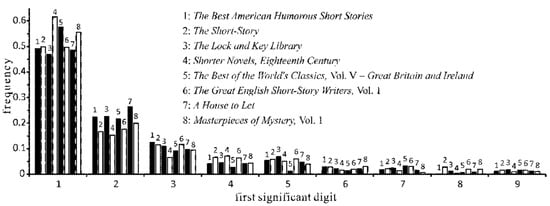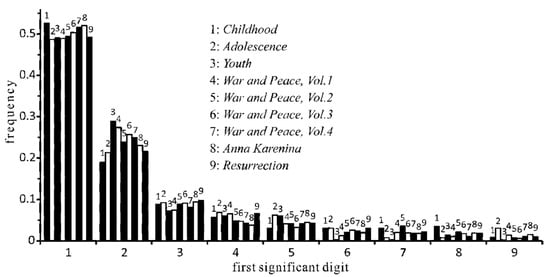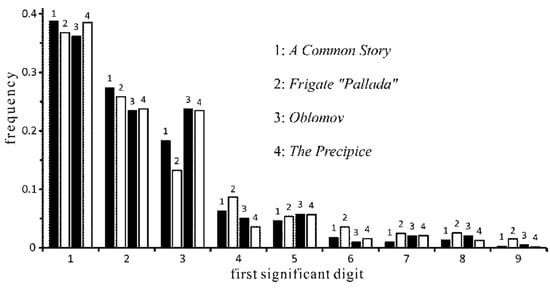Benford’s Law is a strange manifestation of the law of large numbers (understood as the combined action of a large number of random factors leading to a result that is almost independent of the case).
- Benford’s Law
- first significant digit
- numerals in texts
1. Introduction
Benford’s Law is sometimes rightfully called curious, surprising and mysterious [1][2]. There is still no complete understanding of why some data sets obey this law, while others do not. The famous Hill’s theorem [3], which gives sufficient conditions for the appearance of Benford’s Law, does not give the necessary ones nor the insight into why and when Benford’s Law applies.
2. Benford’s Law and Texts
-
Arabic numbers (not spelled out) of consecutive front-page news items of a newspaper. “Dates were barred as not being variable, and the omission of spelled-out numbers restricted the counted digits to numbers 10 and over”;
-
The first 342 street addresses given in an American Men of Science edition;
-
Numeral usage (except for dates and page numbers) of an issue of the Readers’ Digest.
2.1. Distribution of the First Significant Digits of the Numerals in Compiled Texts


2.2. Coherent Literary Texts: The Author’s Peculiarities



2.3. First Significant Digits and Texts Authorship Attribution
3. Beyond the Benford’s Law
Nigrini [15] has elaborated an express technique of Benford’s Law-based accounting fraud detection and an enlarged one.
3.1. The Extension of the Numerals Analysis. Dobychin vs. Platonov

3.2. Who Wrote “The Twelve Chairs”?
This entry is adapted from the peer-reviewed paper 10.3390/stats4040060
References
- Fewster, R.M. A Simple Explanation of Benford’s Law. Am. Stat. 2009, 63, 29–32.
- Blondeau Da Silva, S. Limits of Benford’s law in experimental field. Int. J. Appl. Math. 2020, 33, 685–695.
- Hill, T.P. A Statistical Derivation of the Significant-Digit Law. Stat. Sci. 1995, 10, 354–363.
- Alipour, A.; Alipour, S. Application of Benford’s Law in Analyzing Geotechnical Data. Civ. Eng. Infrastruct. J. 2019, 52, 323–334.
- Mangoua, M.J.; Kouassi, K.A.; Douagui, G.A.; Savané, I.; Biémi, J. Application of Benford’s Law to Hydrogeological Parameters: Case of the Baya Watershed (Eastern Côte d’Ivoire). Asian J. Geol. Res. 2019, 2, 1–7.
- Morag, S.; Salmon-Divon, M. Characterizing Human Cell Types and Tissue Origin Using the Benford Law. Cells 2019, 8, 1004.
- Özkundakci, D.; Pingram, M. Nature favours “one” as the leading digit in phytoplankton abundance data. Limnologica 2019, 78, 125707.
- Cole, M.A.; Maddison, D.J.; Zhang, L. Testing the emission reduction claims of CDM projects using the Benford’s Law. Clim. Chang. 2020, 160, 407–426.
- Vellwock, A.E.; Wei, A. On the Benfordness of Academic Citations. November 2020. Available online: https://www.researchgate.net/publication/345437332_On_the_Benfordness_of_academic_citations (accessed on 29 October 2021).
- Sambridge, M.; Jackson, A. Spotlight on figures for COVID-19. Nature 2020, 581, 384.
- Farhadi, N. Can we rely on COVID-19 data? An assessment of data from over 200 countries worldwide. Sci. Prog. 2021, 104, 1–19.
- Grammatikos, T.; Papanikolaou, N.I. Applying Benford’s Law to detect accounting data manipulation in the banking industry. J. Financ. Serv. Res. 2021, 59, 115–142.
- Dacey, J. Benford’s Law and the 2020 US Presidential Election: Nothing Out Of The Ordinary. Available online: https://physicsworld.com/a/benfords-law-and-the-2020-us-presidential-election-nothing-out-of-the-ordinary/ (accessed on 29 October 2021).
- Kossovsky, A.E.; Miller, S.J. Report on Benford’s Law Analysis of 2020 Presidential Election Data. Available online: https://web.williams.edu/Mathematics/sjmiller/public_html/KossoskyMiller_FinalBenfordAnalysis.pdf (accessed on 29 October 2021).
- Nigrini, M.J. Benford’s Law: Applications for Forensic Accounting, Auditing, and Fraud Detection; John Wiley & Sons: Hoboken, NJ, USA, 2012; 330p.
- Benford, F. The law of anomalous numbers. Proc. Am. Philos. Soc. 1938, 78, 551–572.
- Hungerbühler, N. Benfords Gesetz über führende Ziffern: Wie die Mathematik Steuersündern das Fürchten lehrt. EducETH, Publikation der Eidgenössischen Technischen Hochschule Zürich. 2007. Available online: https://ethz.ch/content/dam/ethz/special-interest/dual/educeth-dam/documents/Unterrichtsmaterialien/mathematik/Benfords%20Gesetz%20über%20führende%20Ziffern%20(Artikel)/benford.pdf (accessed on 29 October 2021).
- Pogorelsky, A.; Titov, V.; Pogodin, M.; Melgunov, N.; Baratynsky, E.; Bestuzhev (Marlinsky), A.; Polevoy, N.; Zagoskin, M.; Rostopchina, E.; Olin, V.; et al. Russian Romantic Novel; Khudozhestvennaia Literatura Publ.: Moscow, Russia, 1989; 384p. (In Russian)
- Novikov, N.; Radishchev, A.; Strakhov, N.; Berezaysky, B.; Karamzin, N.; Zhukovsky, V.; Yakovlev, P.; Pushkin, A.; Odoyevsky, V.; Herzen, A.; et al. Fascinated by the Book. Russian Writers on Books, Reading, Bibliophiles; Kniga Publ.: Moscow, Russia, 1982; 287p. (In Russian)
- Gorky, A.; Romanov, P.; Tikhonov, N.; Fadeev, A.; Kaverin, V.; Nikulin, L.; Babel, I.; Kolosov, M.; Lavrenev, B.; Sokolov-Mikitov, I.; et al. Under Clear Stars. The Soviet Story of the Thirties; The Moscow Worker Publ.: Moscow, Russia, 1983; 130p. (In Russian)
- Morris, G.P.; Poe, E.A.; Kirkland, C.M.S.; Leslie, E.; Curtis, G.W.; Hale, E.E.; Holmes, O.W.; Twain, M.; Edwards, H.S.; Johnston, R.M.; et al. The Best American Humorous Short Stories; The Project Gutenberg eBook: Salt Lake City, UT, USA; Available online: http://www.gutenberg.org/files/10947 (accessed on 10 October 2021).
- Irving, W.; Poe, E.A.; Hawthorne, N.; Bret Harte, F.; Stevenson, R.L.; Kipling, R. The Short-Story; Transcribed from the 1916 Allyn and Bacon edition; The Project Gutenberg eBook: Salt Lake City, UT, USA; Available online: http://www.gutenberg.org/files/21964 (accessed on 10 October 2021).
- Kipling, R.; Conan Doyle, A.; Castle, E.; Weyman, S.J.; Collins, W.; Stevenson, R.L. The Lock and Key Library, Classic Mystery and Detective Stories; Transcribed from the 1909 Review of Reviews Co. edition; The Project Gutenberg eBook: Salt Lake City, UT, USA; Available online: http://www.gutenberg.org/files/2038 (accessed on 10 October 2021).
- Johnson, S.; Walpole, H.; Beckford, W. Shorter Novels, Eighteenth Century. The History of Rasselas, The Castle of Otranto, Vathek; Transcribed from the 1903 Aldine House edition; The Project Gutenberg eBook: Salt Lake City, UT, USA; Available online: http://www.gutenberg.org/files/34766 (accessed on 10 October 2021).
- Boswell, J.; Wordsworth, W.; Scott, W.; Coleridge, S.T.; Southey, R.; Landor, W.S.; Lamb, C.; Hazlitt, W.; De Quincey, T.; Lord Byron, P.B.; et al. The Best of the World’s Classics, Vol. V (of X)—Great Britain and Ireland; Transcribed from the 1909 Funk & Wagnalls Co. edition; The Project Gutenberg eBook: Salt Lake City, UT, USA; Available online: http://www.gutenberg.org/files/22182 (accessed on 10 October 2021).
- Defoe, D.; Hogg, J.; Irving, W.; Hawthorne, N.; Poe, E.A.; Brown, J.; Dickens, C.; Stockton, F.R.; Twain, M.; Bret Harte, F.; et al. The Great English Short-Story Writers, Volume 1; Transcribed from the 1910 Readers’ Library edition; The Project Gutenberg eBook: Salt Lake City, UT, USA; Available online: http://www.gutenberg.org/files/10135 (accessed on 10 October 2021).
- Dickens, C.; Collins, W.; Gaskell, E.; Procter, A.A. A House to Let; Transcribed from the 1903 Chapman and Hall edition; The Project Gutenberg eBook: Salt Lake City, UT, USA; Available online: http://www.gutenberg.org/files/2324 (accessed on 10 October 2021).
- Blackwood, A.; Rhodes James, M.; Rickford, K.; Harvey, W.F.; Adams Cram, R.; Stevenson, R.L.; Steele, W.D. Masterpieces of Mystery, Volume 1, Ghost Stories; Transcribed from the 1920 Doubleday, Page & Co. edition; The Project Gutenberg eBook: Salt Lake City, UT, USA; Available online: http://www.gutenberg.org/files/27722 (accessed on 10 October 2021).
- Kjetsaa, G.; Gustavsson, S.; Beckman, B.; Gil, S. The Authorship of the Quiet Don. Slavica Norvegica; Solum Forlag: Oslo, Norway; Humanities Press: Atlantic Highlands, NJ, USA, 1984; Volume 1, 153p.
- Kuznetsov, F.F. (Ed.) New on Mikhail Sholokhov: Research and Materials; Institute of World Literature: Moscow, Russia, 2003; 450p. (In Russian)
- Eidinova, V.V.; Platonov, A.; Dobychin, L. Stylistic Convergence and Repulsion. Andrei Platonov’s “Land of Philosophers”: Problems of Creativity. In Proceedings of the International Scientific Conference Dedicated to the 50th Anniversary of A. Platonov’s Death, Moscow, Russia, 23–25 April 2001; pp. 211–219. (In Russian).
- Zenkov, A.V. Statistics of Numerals in the Text: Development of a New Method of Stylometry, Advances in Economics, Business and Management Research. In Proceedings of the First International Volga Region Conference on Economics, Humanities and Sports FICEHS 19, Kazan, Russia, 24–25 September 2019; Atlantis Press: Amsterdam, The Netherlands, 2020; Volume 114, pp. 448–451.
- Ščeglov, Y.K. The Novels by Ilf and Petrov. Readers’s Companion; Ivan Limbach Publishing House: St. Petersburg, Russia, 2009; 656p, ISBN 9785890591340.
- Amlinski, I. 12 Chairs from Mikhail Bulgakov; Kirschner: Berlin, Germany, 2013; 328p, ISBN 9783000432842.
- Zenkov, A.; Zenkov, E.; Belke, A. A Novel Text Analysis Method: Numerals Reveal the Author. In Proceedings of the International Scientific Conference on New Industrialization and Digitalization (NID 2020), Ekaterinburg, Russia, 12 December 2020; EDP Sciences: Les Ulis, France, 2021; Volume 93, p. 03026.
- Gan, G.; Ma, C.; Wu, J. Data Clustering: Theory, Algorithms, and Applications, ASA-SIAM Series on Statistics and Applied Probability; SIAM: Philadelphia, PA, USA, 2007.
